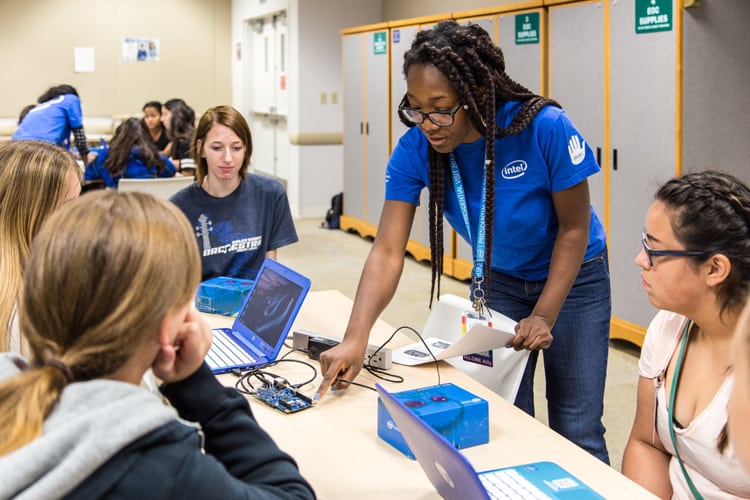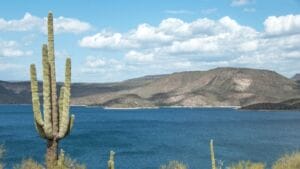Companies are funding philanthropic efforts in science, technology, engineering and math initiatives to boost K-12 education in Arizona and ensure an able workforce.
By 2021, Arizona is projected to have a 21 percent increase in STEM jobs, according to a report by Education Commission of the States.
“The type of jobs available for Arizonans in the future will involve problem-solving, critical thinking and the ability to collaborate and communicate with each other,” said Linda Coyle, director of STEM Education for Science Foundation Arizona.
Arizona businesses are focused on STEM education to equip incoming employees with specialized skills to meet industry needs. STEM network organization Science Foundation Arizona has implemented large-scale initiatives with multiple companies to provide K-12 schools with curricula, resources and professional development training programs for teachers and students.
Major supporters
Tech giant Intel and electric utility company Arizona Public Service are among the 42 advocates in the network.
“Our primary goal is to give local children confidence in STEM,” said Intel engineer Anna Prakash. “Students come from diverse backgrounds and deserve equal opportunity to connect with technology.”
Both companies have grant programs that funded robotics clubs, STEM literacy for students and high-skilled training programs for educators. One Intel employee started a nonprofit with her teenage daughter to empower students through games based on STEM concepts.
Intel had more than 140,000 volunteer hours devoted to STEM last year in Arizona and spent over $1 million in grants to different organizations. The company awards bi-annual seed grants, worth $5,000 each, in which STEM organizations submit proposals for seed funding, an Intel Foundation report stated.
APS has had a mini-grant program for more than a decade to promote STEM initiatives that provide grants of up to $2,500 for teachers to do innovative hands-on projects in their classrooms.
Mallory Lebovitz, APS charity director, said funding STEM education is a great way for a company to invest in its own future.
“We see what the need is now, but also in the future and what is happening in the classroom and how we can make those needs more strategically aligned,” she said.
APS invested $1.4 million into STEM initiatives because Arizona consistently ranks among the fastest-growing states in STEM jobs for manufacturing, energy, cyber security and bioscience, Lebovitz said.
“It’s critically important for our state to stay competitive and continue to nurture the path to meet that demand,” she said.
Filling the gaps
APS is involved with programs that focus on workforce development to reach high school students and integrate skills-based training and concepts, Lebovitz said.
APS also partners with Northern Arizona University. In the program, both teachers and the school leadership build their capacity to design and implement STEM education.
Education consultant Coyle said STEM education teaches students to apply key concepts to real world problems.
“It’s taking those things you learn in STEM and you learn how to apply them out in the community to solve problems,” she said.
Theresa Niemeyer, Intel community engagement manager, said Intel volunteers participate in STEM programs by building personal relationships with students through hands-on interactive lessons.
“We are enhancing the training in the programs so students can work in the tech industry,” Niemeyer said.
Intel’s Prakash received a $5,000 grant for a robotics club. She also co-founded Education Empowers, Inc. with her daughter Elaina Ashton, a high school student in Chandler with a passion for STEM.
Funds from the grant were used to develop curriculum and STEM-inspired games. In each game students were expected to build, design and program robots in 45 minutes. The nonprofit, which aims to close the opportunity gap between privileged and underprivileged students, worked with over 1,000 students in Arizona last year.
Education Empowers, Inc. started numerous after-school robotics clubs in the Valley during its partnerships with the Boy and Girls Club, YMCA and Girl Scouts.
“We use robotics as a main tool for learning because it has components in each part of STEM,” Prakash said.
Engaging students
Intel also worked with the Chandler Unified School District on Project Lead the Way, a hands-on engineering initiative that encouraged students to participate in STEM projects.
“The goal is to excite kids about the idea of STEM,” Lebovitz said. “What is possible, what are the achievements that they could have, if they decided to go into that career path, and break down the stigma that STEM concepts are difficult.”
Many of APS’ STEM programs focus on innovating K-12 education and teacher development, Lebovitz said.
“What we’ve seen in terms of some innovative approaches is that several private and public partnerships are focused on aligning industry needs with field and educational training for students,” charity specialist Lebovitz said.
Research showed that 36 percent of teenage boys are likely to pursue STEM careers, compared to only 11 percent of girls, according to nonprofit, Junior Achievement USA and professional services firm, Ernst & Young. Statistics also showed that women only make up 29 percent of the engineering and science workforce, according to STEM nonprofit, National Girls Collaborative Project.
“We still need to encourage students to engage in the integration of STEM,” education consultant Coyle said. “The grants and programs that I run are focused on young girls and students from underrepresented communities.”
The Intel Foundation has also invested $1 million in partner coalitions as part of its She Will Connect initiative in 2017. The initiative provided STEM training to empower young girls from disenfranchised communities.
Another APS program is a teacher-development project in partnership with the Arizona Science Center that provides teachers with mentors and peer-learning opportunities that focus on rural teachers. These professional development programs have been established in Navajo County and Yuma County. ν




